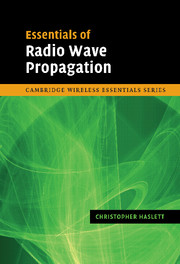Book contents
- Frontmatter
- Contents
- Preface
- Acknowledgements
- 1 Propagation in free space and the aperture antenna
- 2 Point-to-area transmission
- 3 The effect of obstacles
- 4 Reflection, scatter and penetration
- 5 Estimating the received signal strength in complex environments
- 6 Atmospheric effects
- 7 System design and interference management
- 8 Software-based tools
- 9 Summary
- Appendix 1 The decibel scale
- Appendix 2 Phasor arithmetic and phasor diagrams
- Appendix 3 Formula sheet
- Appendix 4 Explanation of the link budget
- Further reading
- References
- Recommendations of the Radiocommunication Bureau of the International Telecommunications Union (ITU), Geneva
- Author's biography
- Index
7 - System design and interference management
Published online by Cambridge University Press: 09 August 2009
- Frontmatter
- Contents
- Preface
- Acknowledgements
- 1 Propagation in free space and the aperture antenna
- 2 Point-to-area transmission
- 3 The effect of obstacles
- 4 Reflection, scatter and penetration
- 5 Estimating the received signal strength in complex environments
- 6 Atmospheric effects
- 7 System design and interference management
- 8 Software-based tools
- 9 Summary
- Appendix 1 The decibel scale
- Appendix 2 Phasor arithmetic and phasor diagrams
- Appendix 3 Formula sheet
- Appendix 4 Explanation of the link budget
- Further reading
- References
- Recommendations of the Radiocommunication Bureau of the International Telecommunications Union (ITU), Geneva
- Author's biography
- Index
Summary
The test of the usefulness of the knowledge gained can best be determined by undertaking some practical exercises that give an insight into problems encountered by radio system designers in the ‘real world’. Firstly, the value of propagation studies in helping to identify the most appropriate frequency for various services is discussed. The system design of microwave links at 10 GHz (at which multipath fading will dominate) and at 23 GHz (at which rain fading will dominate) is explained in some detail. The fact that many thousands of microwave links will be required in an industrialised country leads to a need for interference management, so this topic is introduced. Next, attention is turned to the design of broadcasting systems with a view to obtaining maximum coverage whilst investigating methods of limiting interference at great distances. Additionally, an example of designing a link to a geostationary satellite is presented. Finally, special methods needed for providing and predicting the signal strength for in-building systems are presented.
Determining the most appropriate frequencies for specific services
We have seen that the frequency of operation affects the way in which a radio wave is affected both by obstacles and by the atmosphere and rain. At first sight, it seems that the lower the frequency, the better. Obstacles cause lower levels of diffraction loss at longer wavelengths. Also, the effect of rain and atmospheric absorption is almost negligible below about 5 GHz. Further, the penetration of materials such as concrete is better at lower frequencies.
- Type
- Chapter
- Information
- Essentials of Radio Wave Propagation , pp. 150 - 171Publisher: Cambridge University PressPrint publication year: 2007



